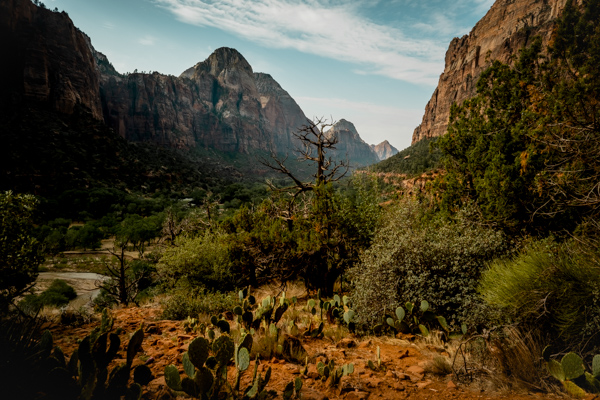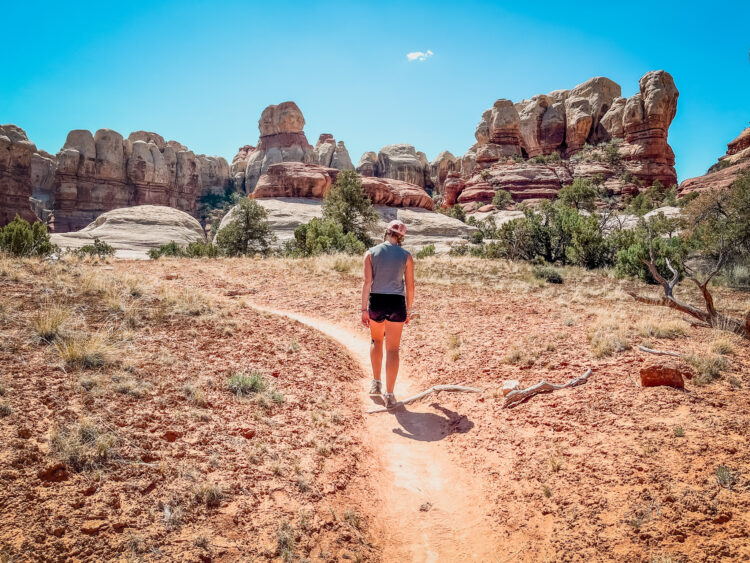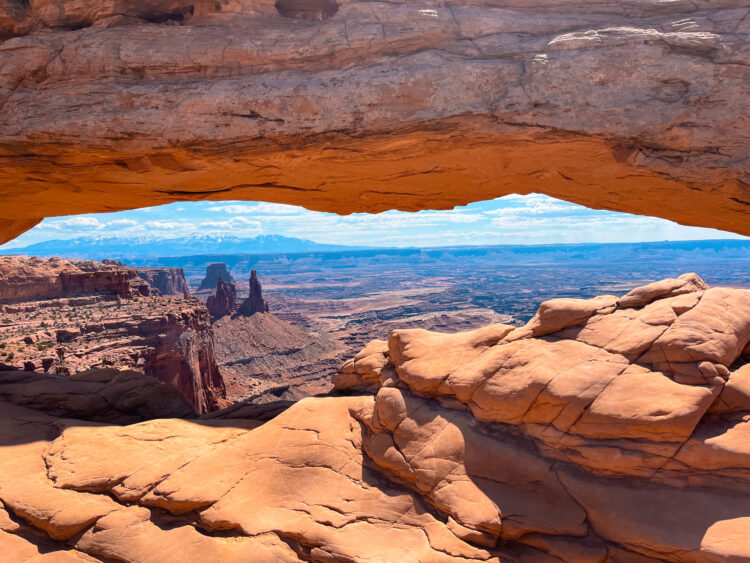From sweeping mountain views to deep canyons carved from red rocks, the US National Parks are highly varied, stunningly beautiful, and full of adventure. These parks have something for everyone. The US National Parks are also generally affordable and make excellent road trips. In this ultimate guide to planning a National Parks Trip, we will go through everything you need to know to choose the best park, create an itinerary and plan the perfect trip.
Below you will find loads of information about planning a trip and can get a free National Parks planning checklist so you don’t forget anything. Our family loves to visit Nationals Parks and we are currently working on visiting all 63 National Parks. You can see more information to help plan your trip on our National Park’s Page.
How to Use This Guide for Planning a National Parks Trip
We’ve created this to help with planning a national Parks trip in the United States. The first section below gives an overview of the things to consider when planning your trip. I suggest you read this first before scrolling to the next section with more specific suggestions on booking lodging, transportation and activities.
Since many of the campgrounds have to be booked 6 months in advance. I recommend that you start planning your National Parks trip 6-8 months before you plan to go. This gives you time to book your transportation and lodging. Activities should be booked 2-4 months in advance (with the exception of the entry times into the parks which should be booked at least 4 months in advance depending on the park).
A Quick Overview of the US National Parks
The National Park system is one of the United State greatest treasures. In 1987, Yellowstone was established as a public park and put under control of the Secretary of the Interior. This act started a domino effect as other countries around the world began to establish their own park systems. Today there are thousands of National Parks in countries around the world. These places are some of the most beautiful in the world and offer opportunities for recreation and conservation.
In the US, there are currently 63 National Parks and even more National monuments and reservations. There are more than 400 sites spread across all 50 states that cover 84 million acres. The US National Parks are the perfect places to explore on your next road trip!

What to Consider When Choosing a National Park
The first thing when planning a National Parks trip is to decide which park (or parks) to explore. There are many factors that will impact the best park for you to explore such as how long you have, what time of year you’ll be traveling, and your budget. There is no ‘Best’ National Park as each park has something to offer. Below you can see some of the most important things to consider.
If you are Planning a US National Parks trip with older kids, check out: The 10 Best US National Parks for Teens.
Weather
Weather will likely play a crucial role on which National Park to visit. If you are planning your trip for a certain time of year, you will want to select a National Park that is enjoyable during that season. For example, winter may not be the best time to visit some of the more remote Alaskan National Parks, or summer may be too hot to hike in the Grand Canyon.
On the other hand, you may have a specific National Park in mind and have the flexibility to choose what time of year is the best to visit. If you are hoping to visit the Everglades, make sure to research the best time of year to visit the park. Pay attention to the high and low temperatures, the chance of precipitation, and the other related factors like bugs and road closures during different seasons.

Type of Activities
The type of National Park and the activities, wildlife and natural sites are likely what will draw you to a a specific park. If you love mountains and hiking you will want to select a park like the Grand Tetons. If you love rocky shorelines, a National Park like Acadia is the perfect destination. If you want to explore amazing views and canyons, consider visiting Zion.
Spend time researching the National Parks to choose the park or parks that you you want to visit. You can see a list of our favorite resources below or get a National Parks book that you can keep around the house and loook through for inspiration.
Crowds
National Parks are popular and many of them get millions of visitors every year. While the best time to visit the Grand Tetons might be in the summer, this is also the time of year that the park is the most crowded. This means that lodging will fill up, parking lots won’t have space, and for some parks (like Rocky Mountain National Park) you will need to book a timed entry months in advance.
If you have the flexibility, planning a National Parks trip during the shoulder season means less crowds and decent weather. Sometimes it’s unavoidable, so if you are planning to visit during the busy season, plan for the crowds.
Length of the Trip
Some National Parks are nearby and small and can be visited quickly. Some National Parks (like Yellowstone) are large and take multiple days to fully explore. You may also want to link several National Parks together into a National Parks road trip. If you only have a long weekend, you may want to choose a single National Park, but if you have a week of more you can consider a longer trip.
We spent 1 month exploring National Parks during the summer of 2021 and you can see our itinerary here.
Location
The location of the National Park is also an important factor. It’s obviously easiest to visit a nearby park and will be cheaper as you can drive there and won’t need to the extra expenses of airplane tickets and a car rental. If you are planning on flying and visiting a park, you will want to look at which parks are near a major airport.
Budget
One of the best things about visiting a National Park is that you can do it relatively cheaply. If you are traveling on a budget, you can plan a road trip to the nearest park and plan to camp and cook your own food. On the other hand, if you have the budget and are looking for something with a bit more luxury, you can find higher end lodging and pre-arranged activities built up around many National Parks.

National Parks Trip Planning
Once you’ve decided which park or parks you want to visit, you can start to dive deeper into planning a National parks trip. The next section will walk you through some of the steps you can take and the tools you can use to start planning. We recommend starting with researching the parks that interest you, creating an itinerary, then selecting transportation, lodging, and activities.
Researching the National Park(s)
There are so many amazing resources to learn about and explore the National Parks. From inspiration on Instagram to travel websites and guide books, there is so much information available. Below you can find links to a few of our favorite websites that we use to help plan out National Park travels:
- Chasing ADVNTR (check out the resources on our planning page)
- Earthtrekkers
- Renee Roaming
- National Parks Service
We also love to have National Parks Guidebooks to plan our travels. Many of the National Parks have limited cell service, so it’s best not to rely only on the internet when visiting. Look for a guidebook that fit with your travel style. We love the Lonely Planet books and they have just come out with a new series of books about the National Parks.
Planning an Itinerary
Planning an itinerary can either be fun or daunting. You can read more about how we plan our road trips in the this post. The first thing we do when planning a National Park trip itinerary is to drop the places we want to visit or activities we want to do into a map.
It’s easy to create a map using google my maps. Visit www.google.com/mymaps. You can search for different sites on the map and then save them. This will give you a sense of where in the park you want to visit as well as how to link the different activities into an itinerary. This is works well as a National Park route planner as you can add lines to connect different attractions.
Once you have this completed, you can start to build a day by day itinerary using either a spreadsheet, word document, or a traditional pen and paper.

Transportation
Transportation is important for two reasons – how you will get to the National Park and how to get around the National Park. It is possible to visit many of the National Parks by taking public transportation to the region and then relying on park shuttles to get around. Some parks are well set up for this and others don’t have a shuttle or have a very limited shuttle, so don’t assume that the park has public transportation. Below you can find more information on finding the best transportation for planning a National Parks trip.
Tour Companies
You can also arrive at the National Park and then arrange to visit the park itself via tour companies. There are many tour companies that book day long or even week long tours of National Parks. You can search locally, or on Viator to see different options. Often the hotel, resort or campsite can help to arrange local tours or point you in the right direction.
Cars
In general, the best way to visit a National Park is to have your own vehicle. This gives you the ultimate flexibility for both getting to the park and getting around to the park. Even if the National Park has a shuttle (like Zion) many of the interesting places to visit aren’t on the shuttle route.
The downside of a car is that you will have to organize parking and deal with traffic. If you are visiting during the parks busy season, you may experience full parking lots and traffic getting into the park or the popular attractions. Always try to visit early or late in the day and be prepared for driving complications.
If you are flying to the area, you will need to rent a car. Consider searching for a reasonable car rental at Discover Cars.
Campervan or RV
Another popular option for visiting a National Park or taking a National Parks road trip, is to take a campervan or an RV. This combines your transportation and lodging into one option. This can be great be a great choice for longer road trips and is more comfortable than a car.
The negative to this is that RV’s are difficult to park and many National Park roads are narrow and windy.
Airplanes
Unless a National Park is near to your home or you are going on an extended road trip, you will likely need to fly to reach the park. Many US National Parks are easy to reach from a major airport although some of the more remote parks are only reachable via small airport. Often you can fly into an airport and visit several National Parks in one trip. A good example of this is visiting both Arches National Park and Canyonlands National Park.
Other Transportation Options
While cars, tours, shuttles, airplanes and RV/campervans are the easiest ways to get around most National Parks, you can also get creative and visit the parks in other ways. Consider a motorcycle, biking packing, boating, or other methods to get around.

Lodging
Just like transportation, there are several different options for where to stay when you are visiting National Parks. If you are visiting on a budget or like being directly in nature, you can camp. Most parks also have clamping options or small cabins. Several National Parks have lodges within them, or you can find hotels just outside to gates or in a nearby town, or book a short term house rental. Below are some suggestion on booking different types of lodging when you are planning a National Parks trip.
Camping
Camping is a great, popular and generally inexpensive option. There will be some up front costs if you don’t already have the camping gear. Most campgrounds cater to both tent campers as well as campervans and RVs. When you are looking for a campground the best places to find a campsites is:
- An official NPS campground within the park: most sites book 6 months in advance and fill up quickly. Book through www.recreation.gov.
- A backcountry site – some are first-come but you can also research online at www.recreation.gov.
- A private campground – search locally for campsites near the National Park.
- A nearby State Park or local park – many local parks also have campgrounds.
Glamping
There are more and more impressive glamping options available at many National Parks. Glamping typically refers to sleeping in a variety of semi-permanent building or even tents. Glamping can include yurts, teepee style tents, cabins, etc. Consider searching on Hip Camp to find glamping options.
Lodges in the Park
Several of the National Parks have lodges within the park that are open either seasonally or year-round. These often make great options and they serve meals right at the lodge. You also get access to the park during the early and late day when most people have gone for the day and the park is less crowded.
Hotels and Resorts Outside the Park
Most National Parks have a nearby town with hotels or a series of hotels and resorts that have been built up right outside the entrance to the park. These hotels range from budget options to high end resorts and bed and breakfasts. When booking a hotel, consider the amenities and also how long it will take to get to the attractions in the park.
Search for lodging option in booking.com or search on google. Make sure to read reviews so you know what you can expect.
Rental Properties
One other option to consider is renting a property. This is a great option if you are traveling with a large group, are looking for something unique or want to spend a longer time at the National Park. Many house rentals can be booked directly through VRBO.

Activities
Once you’ve planned your lodging and transportation, the next step is to plan some activities. Most National Parks are full of activities and you can either book activities in advance or visit the visitor center when you arrive for recommendations. Start your visit with a drive on the scenic road (found in most parks) and stop at the scenic overlooks.
From here select a few hikes based on your interest and hiking ability. You can find suggestions for many hikes in our National Parks section, search on All Trails, or check out suggestions at the park service or online. As mentioned you can find amazing tours and activities on Viator – click on the banner below to save on some tours.
Plan and keep track of your National Parks hikes with this bundle on our Etsy Shop.
National Parks Pass and Reserving Entry
It’s important to note the in order to enter a National Park, you will need to purchase a National Parks Pass or buy single entry to the park you’re visiting. If you plan to visit more than one or two national parks, it is worth it to get an America the Beautiful pass. You can see more about the pass options on the NPS site. If you happen to have a 4th grader, make sure to check out the program for 4th graders to get into the National Park for free.
In addition to the entry fee, many of the US National Parks now have a timed entry system to get into the park in order to limit the number of visitors. These need to be booked well in advance (often 120 days in advance). If you don’t get a timed entry, you will have to visit another part of the park or skip the park all together. As soon as you begin planning a National Parks trip, look to see if the National Park has a timed entry system.
Making the Most out of Your National Parks Trip
Planning your National Parks trip is one part of having the perfect trip, the other part is ensuring that you have a great time while you’re there. This includes being prepared and packing the right things.
Leave No Trace
No matter where you go and how you choose to travel, it’s important to practice leave no trace. This means that you stay on the trail, pack out your trash, avoid feeding and impacting the wildlife and use the facilities as directed.
Packing list
Packing for a National Park varies greatly with where you are, what you plan to do, and the time of year you’ll be visiting. In general you should plan to pack layers of clothing that can be shed or added during the day based on the temperature. Below are some National Park essentials that are appropriate for most National Parks:
- You will also want to pack hiking boots/shoes to get around the park safely. You can find a guide to the best hiking shoes under $100.
- Hiking Pack – a good day hiking pack is important when planning a National Parks trip. You can find our favorite daypacks here.
- No matter where you plan to hike, you should plan to bring some hiking basics. You can see a list of what goes into our day hiking pack here.
- National Park map and guidebooks. Whether you get a guidebook or simply get a map and information at the visitor center, a good book is a great tool for visiting a National Park.
Special Considerations for Planning a National Parks Trip
Below you can find a few special situations for planning a National Parks trip.
Traveling with Kids
Visiting the National Parks with kids is a great vacation and can be fun for everyone! National parks offer incredible activities and whether your kids love nature, adventure sports or history, most National Parks offer something your kids will enjoy.
No matter that age of your kids, you can enjoy staying in a hotel, renting a house or camping. My kids love to camp and have enjoyed the National Park campsites. You will want to plan age appropriate hikes for kids in your group. A good rule of thumb to follow when your kids are young is that they can hike about 1 mile for every year of their age.
For young kids make sure to stop at the visitor center to find out what activities are available for kids and to get their passport stamped.
Traveling with Pets
Most National Parks in the United States offer restrictions on bringing pets into the park. There are just a few parks that allow dogs (such as Acadia). If you are planning to travel with pets, it is a good idea to look ahead and make sure you have a safe place for your pets while you explore the park. Avoid leaving your pets in the car or in a hotel room for a long period of time.
Seeing all the National Parks
Once you’ve seen one National Park, you may just want to visit them all. Many people make it a lifetime goal to visit every US National Park. Our family is currently on a mission to see every park in the country (you can see some of our other goals in this post). While the best way to do this is to simply drop everything, buy a campervan and hit the road, this is impractical for most people. Most people keep a running list and slowly check off the parks as they visit them. If you are planning to do this, take a look at the map of the National Parks and figure out how to link together some of the parks.
For example, many people visit the 5 National Parks in Utah on a single road trip. It’s also possible to combine other parks together as well.
There are currently 63 National Parks and it will likely take years to visit them all. If your goal is to visit every one, then planning a National Parks trip will likely also involve figuring out how to maximize your travel time!
If you want a simple National Parks checklist, visit our Etsy Shop.











